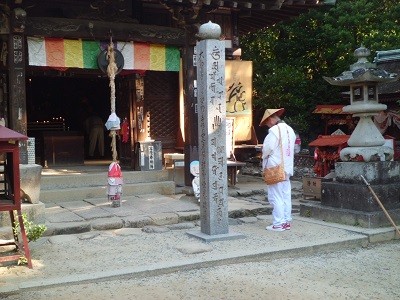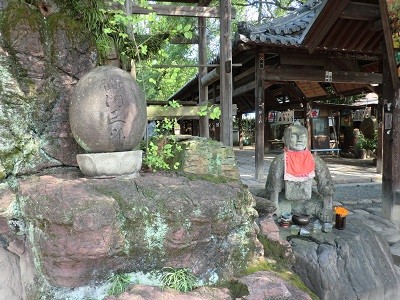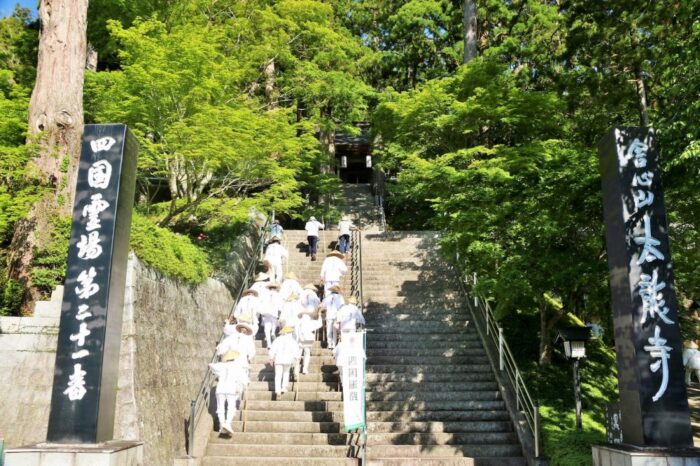Shikoku is the fourth largest island in Japan after Honshu, Hokkaido, and Kyushu. This is the only big island that is not serviced by a shinkansen or bullet train. It means that you can visit this beautiful and peaceful island slowly. There are many attractions in Shikoku, from historical places to the great outdoors. One of the best ways to enjoy what Shikoku has to offer is by doing (a part of) the famous Ohenro (遍路) pilgrimage. The route consists of 88 Buddhist temples that are scattered all over the island. Let’s find out its history and why it attracts many people.
History of the Shikoku Pilgrimage
The pilgrimage is related to a monk called Kukai (774 – 835). Kukai was later called Kobodaishi (Great Master Kobo), and he founded the Shingon sect of Buddhism. He was born in Shikoku and took ascetic training to reach enlightenment. He went to China from where Buddhism was brought. After he came back, he founded the main temple of the Shingon sect on the mountain of Koyasan in Wakayama Prefecture.
It is said the pilgrimage follows the route which Kukai took after his death. It is not known who designated the 88 temples and when this happened. All we know is that it was not Kukai. It is said that his followers gradually decided on which temples became a part of the pilgrimage. Great monk Shinnen published the first guidebook introducing the 88 temples in 1687. After that, pilgrimage became very popular throughout the Edo Period (1603 – 1867).
The popularity of pilgrimage did not only increase in Shikoku but all over Japan. Common people could not travel outside of their towns in those days, but pilgrimage was an exception because of several factors. Many people started traveling to Ise Shrine, Kumano Shrine, and other religious places including Shikoku.
Pilgrimage Today

The total distance of the route is 1,100 to 1,400 km. The distance is not fixed because there are several possible routes that allow you to visit all the temples. If you walk, it normally takes about 40 days. The number of pilgrims today is estimated at 100,000 to 300,000 per year, and about 2,500 to 5,000 of them do it on foot. The rest uses cars or tourist buses. It may take approximately 10 days if you use a car. Besides these options, there are a lot of organized tours for pilgrims.
You don’t have to visit all 88 temples at once. You can also split up the route and visit several temples at one time. The temples have numbers from 1 to 88, but you don’t have to start from one. You can choose to visit them clockwise or counter-clockwise.
It is believed that if you visit the 88 temples counter-clockwise in a leap year, you will be blessed threefold because of the legend of Emon Saburo. He wanted to meet Kukai to apologize to him, so he tried walking the route clockwise 20 times but he never met Kukai. However, when he attempted the route counter-clockwise in a leap year once, he finally met Kukai.
After visiting all 88 temples, finally, you are supposed to visit Koyasan. This is the headquarter of the Shingon sect which Kukai established. Then your wish will come true. You will not only be blessed, but you will enjoy a sense of accomplishment when you finish.
Pilgrimage Costume
You can recognize the pilgrims easily because they wear white clothes with sutras written on it. It is actually the outfit for the dead. It means that they are not afraid of death while taking this pilgrimage. They also have wooden sticks which represent Kukai. This symbolizes that even though you are walking by yourself, you are always with Kukai. Some pilgrims may wear straw hats.
Settai or Osettai
Settai literally means ‘offering hospitality’. There used to be a lot of facilities to help pilgrims voluntarily, for example, offering free food, drinks, and accommodation. For the locals, offering hospitality to pilgrims means offering it to Kukai.
Nowadays, there are not many as many facilities as there used to be. You can still find some resting spaces, temples, or free private accommodation. If you receive hospitality, you are supposed to give an amulet in return. But even if they don’t receive anything, they receive at least a blessing from the deities. Many people mention that what impressed them most during the pilgrimage is the hospitality of the local people.
Ryozenji Temple
Each temple has a serial number. Ryozenji is the number one temple in Tokushima. It was established in the 8th century by famous monk Gyoki. Then in 815, Kukai came to this temple and practiced meditation for 21 days. During his practice, he had a feeling that he was in Ryojusan where Buddha once preached to the worshipers. So he renamed the temple Ryozenji and donated a statue of the Shakyamuni Buddha.
Ishiteji Temple

This is temple no. 55, which is one of the most visited temples out of 88. Because it is located close to the famous hot spring town Dogo in Matsuyama City, it is especially popular. Additionally, this is the temple related to Emon Saburo who met Kukai. His statue can be found on the temple grounds.
A big statue of Seian-daishi, which is 16 meters high, is on the mountain behind the temple. Entrance gate Nio-mon, constructed in 1318, is designated as National Treasure. Visiting the cave that represents Mantra (sacred words) may be interesting. There are many Buddhist statues in the cave.
Your Japan Tour
As seasoned Japan experts, we can help you create your perfect Japan tour. We can provide you with guides who can tell you all about the history and culture of the pilgrimage of Shikoku and take you there. Contact us to start planning your unforgettable holiday to this fascinating country. Japan is full of once-in-a-lifetime experiences, culture, history, nature, and delicious food!
